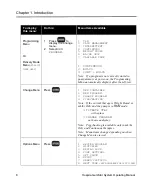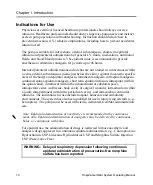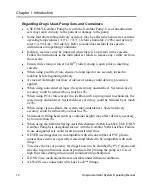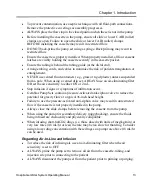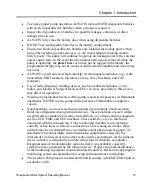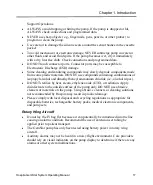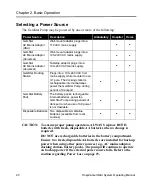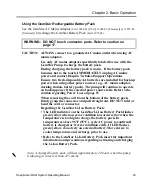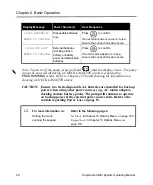
Hospira GemStar System Operating Manual
15
Chapter 1. Introduction
6
To ensure proper pump operation, ALWAYS replace BOTH disposable batteries
with fresh, disposable AA batteries when a change is required.
6
Inspect the disposable AA batteries for possible leakage, corrosion, or other
damage prior to use.
6
ALWAYS fully close the battery door when using disposable batteries.
6
DO NOT use rechargeable batteries in the battery compartment.
6
Ensure two fresh, disposable AA batteries are installed for backup power when
using other external power sources (e.g., AC mains adaptor, docking station,
battery pack). The pump will continue to operate on backup power if the external
power source fails. In the event that the internal batteries are removed while the
pump is operating, the
power loss
event may not be logged in the history, the
programmed therapy may not be retained, and the alarms (audible and visual) may
not occur.
6
ALWAYS avoid sources of high-intensity electromagnetic radiation (e.g., radio
transmitters, MRI scanners, microwave ovens, X-ray machines, and CAT
scanners).
6
Use of radio-frequency emitting devices, such as cellular telephones, 2-way
radios, and Electrical Surgical Devices (ESU), in close proximity to this device
may affect its operation.
6
Possible explosion hazard exists if the pump is used in the presence of flammable
anesthetics. NEVER use the pump in the presence of flammable or explosive
vapors.
6
Non-hazardous, low-level electrical potentials are commonly observed when
fluids are administered using infusion devices. These potentials are well within
accepted safety standards, but may create artifacts on voltage-sensing equipment,
such as ECG, EMG, and EEG machines. These artifacts vary at a rate that is
associated with the infusion rate. If the monitoring machine is not operating
correctly or has loose or defective connections to its sensing electrodes, these
artifacts may be accentuated so as to simulate actual physiological signals. To
determine if the abnormality in the monitoring equipment is caused by the
infusion device instead of some other source in the environment, set the infusion
device so that it is temporarily not delivering fluid (if clinically acceptable).
Disappearance of the abnormality indicates that it was probably caused by
electronic noise generated by the infusion device. Proper setup and maintenance
of the monitoring equipment should eliminate the artifact. Refer to the appropriate
monitoring system documentation for setup and maintenance instructions.
6
The GemStar Pump has been tested and found to comply with EMC/EMI limits in
accordance with:
Summary of Contents for GemStar Series
Page 9: ...Notes viii Hospira GemStar System Operating Manual ...
Page 27: ...Notes 18 Hospira GemStar System Operating Manual ...
Page 67: ...Notes 58 Hospira GemStar System Operating Manual ...
Page 77: ...Notes 68 Hospira GemStar System Operating Manual ...
Page 87: ...Notes 78 Hospira GemStar System Operating Manual ...
Page 95: ...Notes 86 Hospira GemStar System Operating Manual ...
Page 103: ...Notes 94 Hospira GemStar System Operating Manual ...
Page 165: ...Notes 156 Hospira GemStar System Operating Manual ...
Page 173: ...Chapter 14 Operation Test 164 Hospira GemStar System Operating Manual ...
Page 175: ...Notes 166 Hospira GemStar System Operating Manual ...
Page 193: ...Notes 184 Hospira GemStar System Operating Manual ...
Page 221: ...Notes 212 Hospira GemStar System Operating Manual ...








